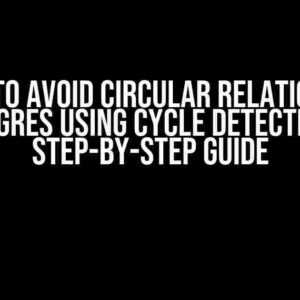CRUD (Create, Read, Update, Delete) operations are the backbone of any modern web application. They allow users to interact with data, creating a seamless experience. However, issues with performing CRUD operations can bring your application to a grinding halt, leaving users frustrated and confused. In this article, we’ll dive deep into the common issues that arise when performing CRUD operations, and provide step-by-step solutions to resolve them.
Understanding CRUD Operations
Before we dive into the issues, let’s quickly review what CRUD operations entail:
- Create: Adding new data to a database or storage system.
- Read: Retrieving existing data from a database or storage system.
- Update: Modifying existing data in a database or storage system.
- Delete: Removing data from a database or storage system.
Common Issues with CRUD Operations
Now that we’ve covered the basics, let’s explore the common issues that developers face when performing CRUD operations:
Data Integrity Issues
Data integrity refers to the accuracy and consistency of data within a database or storage system. Issues with data integrity can arise due to:
- Inconsistent data formats
- Invalid data entries
- Data redundancy
To resolve data integrity issues, follow these steps:
- Validate user input to ensure accurate and consistent data entry.
- Implement data normalization techniques to reduce data redundancy.
- Use data validation rules and constraints to prevent invalid data entries.
Authorization and Authentication Issues
Authorization and authentication issues occur when users are unable to access or modify data due to permission restrictions or incorrect login credentials.
To resolve authorization and authentication issues, follow these steps:
- Implement a robust authentication system using secure protocols such as OAuth or JWT.
- Define clear permission levels and access controls for different user roles.
- Use secure password hashing and salting to protect user credentials.
Database Connection Issues
Database connection issues occur when the application is unable to establish a connection with the database or storage system.
To resolve database connection issues, follow these steps:
- Check the database connection string for errors or typos.
- Verify that the database server is running and accessible.
- Use a connection pooling mechanism to improve connection efficiency.
CRUD Operation Errors
CRUD operation errors occur when the application encounters issues during the creation, reading, updating, or deletion of data.
To resolve CRUD operation errors, follow these steps:
- Use try-catch blocks to catch and handle exceptions during CRUD operations.
- Implement transactional behavior to ensure atomicity and consistency.
- Use logging mechanisms to track and debug CRUD operation errors.
Best Practices for Performing CRUD Operations
To avoid issues with CRUD operations, follow these best practices:
Use a Consistent Data Model
Use a consistent data model throughout your application to ensure data integrity and reduce errors.
// Example of a consistent data model
public class User {
public int Id { get; set; }
public string Name { get; set; }
public string Email { get; set; }
}
Implement Error Handling
Implement robust error handling mechanisms to catch and handle exceptions during CRUD operations.
try {
// Perform CRUD operation
} catch (Exception ex) {
// Log and handle the exception
Console.WriteLine("Error: " + ex.Message);
}
Use Transactions
Use transactions to ensure atomicity and consistency during CRUD operations.
using (var transaction = db.Database.BeginTransaction()) {
try {
// Perform CRUD operation
transaction.Commit();
} catch (Exception ex) {
transaction.Rollback();
// Log and handle the exception
Console.WriteLine("Error: " + ex.Message);
}
}
Optimize Database Queries
Optimize database queries to improve performance and reduce errors.
// Example of an optimized database query
var users = db.Users.Where(u => u.Name == "John Doe").ToList();
Conclusion
In conclusion, issues with performing CRUD operations can be resolved by understanding the common issues that arise, implementing data integrity measures, authorization and authentication mechanisms, and following best practices for error handling, transactions, and database query optimization. By following these steps, you can ensure that your application provides a seamless experience for users, reducing errors and improving overall performance.
FAQs
Q: What is the most common issue with CRUD operations?
A: Data integrity issues, such as inconsistent data formats and invalid data entries, are the most common issues with CRUD operations.
Q: How can I improve the performance of CRUD operations?
A: You can improve the performance of CRUD operations by optimizing database queries, using connection pooling, and implementing caching mechanisms.
Q: What is the best way to handle errors during CRUD operations?
A: The best way to handle errors during CRUD operations is to use try-catch blocks, implement transactional behavior, and log and debug errors.
| CRUD Operation | Description |
|---|---|
| Create | Adding new data to a database or storage system. |
| Read | Retrieving existing data from a database or storage system. |
| Update | Modifying existing data in a database or storage system. |
| Delete | Removing data from a database or storage system. |
This comprehensive guide has covered the common issues that arise when performing CRUD operations, as well as the best practices and solutions to resolve them. By following these steps, you can ensure that your application provides a seamless experience for users, reducing errors and improving overall performance.
Frequently Asked Questions
Having trouble with performing CRUD (Create, Read, Update, Delete) operations? You’re not alone! Here are some common issues and their solutions:
Why am I getting a 404 error when trying to create a new resource?
This error usually occurs when the API endpoint is incorrect or the resource doesn’t exist. Double-check your API endpoint and make sure you’re sending the request to the correct URL. Also, verify that the resource you’re trying to create doesn’t already exist.
Why can’t I read the data I just created?
This could be due to permission issues or incorrect API endpoint. Ensure that you have the necessary permissions to read the data and that you’re using the correct API endpoint to retrieve the data. Also, check if the data is being cached and if so, try refreshing the cache.
How do I update a resource without overwriting its existing data?
To update a resource without overwriting its existing data, use the PATCH method instead of PUT. PATCH allows you to update specific fields of the resource without affecting the rest of the data. Make sure to specify the fields you want to update in the request body.
Why is my delete operation not working?
This could be due to permission issues, incorrect API endpoint, or the resource not existing. Ensure that you have the necessary permissions to delete the resource and that you’re using the correct API endpoint. Also, verify that the resource exists and that you’re sending the correct request method (DELETE).
What are some common mistakes to avoid when performing CRUD operations?
Some common mistakes to avoid include using the wrong HTTP method, incorrect API endpoint, and not validating user input. Additionally, ensure that you’re handling errors and exceptions properly to avoid data inconsistencies and security vulnerabilities.




